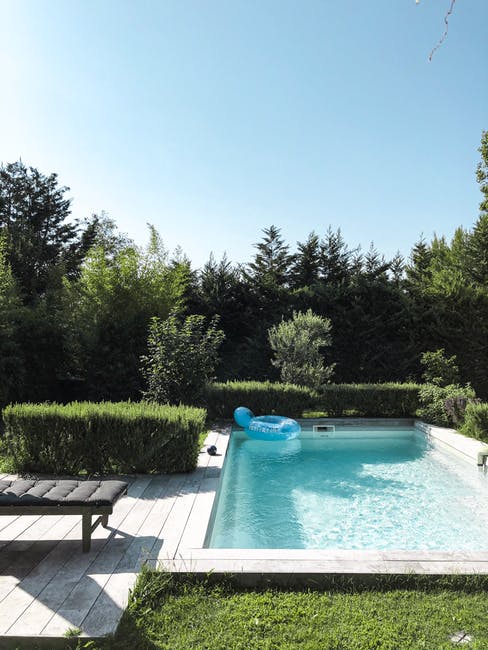Are you thinking about installing an inground pool in your yard?
Installing an inground pool offers many benefits. Not only does it allow for more fun in the sun with friends and family, but an inground pool can also raise the value of your home.
But, you’re probably wondering what type of inground pool you should install. There are a lot of types of inground pools out there, and each one comes with its own unique benefits and drawbacks.
So, if you’re new to the world of inground pools, keep reading.
This guide will cover everything you need to know about the different types of inground pools.
1. Concrete Pools
Concrete pools are without a doubt the most popular type of inground pools.
The most important thing to note about concrete pools is that there are several different types available. These types are:
- Gunite
- Shotcrete
- Cast
Because each concrete type offers something different, let’s take a look at their benefits and drawbacks separately.
Gunite
Often referred to as dry gun concrete, gunite pools are made from a dry mix.
In terms of strength and water tightness, gunite is your top choice out of all the concrete options. Also, gunite allows for size customization. In fact, all concrete pools can be easily customized by size, which is perhaps why so many people love them.
Also, there’s a lot of design flexibility when it comes to gunite. It’s completely up to you in terms of what you choose for tiles, plaster, or paint.
The biggest downside to gunite is that it’s extremely expensive to refinish. And, because concrete is extremely porous, chemical and filtration are required to prevent algae.
Shotcrete
Shotcrete is very similar to cast, except for that it contains less water in its mixture.
In order to build a shotcrete pool, the builder sprays the mixture into place in layers. This helps result in a strong, watertight pool surface.
Just like gunite, shotcrete is known for its versatility, strength, and watertight properties.
Cast
The final concrete option is cast.
To build a cast concrete pool, builders first start with a form that’s either made from wood or steel.
They then pour the mixture of concrete into the form. This allows for a smooth and soft waterproof surface. Due to its smooth surface, cast is also a popular choice for pool floors.
Cast is also the most common concrete pool type, which means that most builders have plenty of experience with installing it.
General Advantages and Disadvantages of Concrete Pools
Now that you know about the different concrete types, let’s look at some general advantages and disadvantages of concrete pools.
Here are the biggest advantages:
- Customization: Customization options are practically limitless when it comes to the size and shape of the pool
- Durability: Concrete pools are extremely durable. You never have to worry about sharp objects damaging the interior of the pool like you would with other materials
Then, here are the biggest disadvantages:
- Require more hands-on maintenance
- Need to use more chemicals to keep them clean and prevent algae formation
- Incompatible with salt
- Rough interior surface
- Slow installation time
Even with these disadvantages, keep in mind that concrete pools are still one of the most popular options, so people clearly love them for a reason.
2. Fiberglass
Fiberglass pools are one-piece pools. In other words, they’re made in a factory from a mold and then shipped to your home.
But, don’t think the delivery process is as easy as ordering something off of Amazon Prime. A truck will deliver the 2500-3500lb pool to your home. Then, a pool installer will need to come over with a forklift to take it off the truck and move it to the construction site.
This is of course after they’ve done all the site planning and excavation.
However, the installation process is actually extremely quick when compared to other types of inground pools, which is why people love this material so much.
Here are some other advantages to fiberglass pools:
- Due to the non-porous surface of the pool, fiberglass is incredibly easy to maintain
- Because fiberglass pools have no liner, you never need to worry about puncturing the pool
- Their shells generally require very little repair, which makes them extremely affordable
- Compatible with salt systems
- Fiberglass pools are considered extremely attractive and elegant looking
- Low lifetime cost of ownership
There are, however, a few drawbacks to fiberglass pools. These include:
- Not much room for size and shape customization
- High initial costs
- Difficult to color match when repairs are needed
3. Vinyl Pools
Last but not least, we have vinyl inground pools.
To build a vinyl pool the site must first be properly excavated. Then, a frame will be built that’s either made from wood, metal, or plastic. This will allow the installers to build the wall panels, install the liner, and pour a sand base.
So, what is it that people love about vinyl pools? Here are the main advantages:
- Low installation cost: Vinyl pools actually have the lowest installation cost of all three pool types
- Unlimited options when it comes to pool size and shape
- Experience very minimal algae growth
Here are the biggest drawbacks to a vinyl pool:
- Replacing the liner gets costly, as it needs to be replaced frequently. On average, the liners last 8 to 12 years and cost a few thousand dollars to be replaced
- Liner warranty isn’t always straightforward
- The liner color will fade over time due to chemicals
- Sharp objects can easily tear vinyl liners
Types of Inground Pools: Which Will You Choose?
Now that you know about the different types of inground pools, it’s time to decide which one is right for you.
If you’re stuck on what type of pool to choose, contact our team. We’ll help you choose the right pool for your needs.




